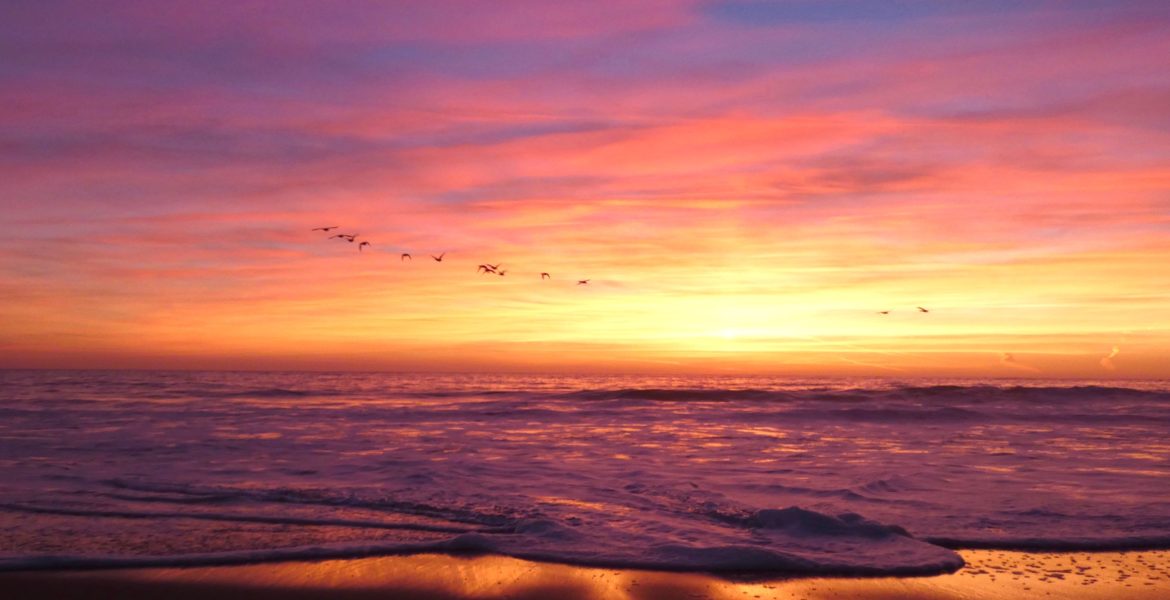Watch for sunsets, supermoons and seabirds this season.
Every winter, the Sun, Moon and Earth align to create extreme low and high tides. While “king tides” can flood beaches and swamp roads and beachside buildings, the corresponding low tides reveal a usually unseen world of tide pools and impossibly wide expanses of sand.
A low tide winter beach walk offers empty beaches, and the potential to see a vivid winter sunset and watch for migrating gray whales. There’s even a good chance of catching the elusive sunset “green flash,” on a winter evening.
Winter low tides are a birdwatcher’s paradise, as shorebirds take advantage of an all-you-can-eat seafood buffet revealed by the retreating sea. Often, the birds are a walker’s only company. For solitude seekers, the winter beach is a terrestrial paradise.
Although humans have been able to predict and chart tides for hundreds and even thousands of years, the science of tides is complex. Earth and the Moon have elliptical orbits, and the tidal variation in Earth’s oceans are created by the changes in gravitational pull between the Earth, the Moon and the Sun.
Spring tides occur at every full and new moon— spring referring not to the season, but to how the water springs onto the land.
The highest spring tides occur during perigee, when the Moon is closest to the Earth. Perigean spring tides, also called “king tides,” are the biggest tides of the year. They occur when the gravitational pull between the Sun, the Earth and the Moon is strongest, usually at Midwinter, when the Earth is closest to the sun—perihelion, and at midsummer, when it is at the furthest point in its elliptical orbit—aphelion.
In the U.S., tides are measured in feet, and the difference between a perigean spring tide and an ordinary spring tide is only a few inches, but it’s enough to make a big difference.
February 6-8, one of two king tides in 2020, brings spectacularly low tides all three days—a -1.37 low tide at 2:32 p.m. on Friday, February 6; a -1.57 tide on Saturday, February 8 at 3:08 p.m.; and a -1.37 low tide on Sunday, February 9, at 3:45 p.m.
The February full moon rises on the 8th at 5:03 p.m., adding another inducement for a sunset beach walk.
The March full moon will be one of two 2020 “supermoons,” because it occurs when the moon is closest to the Earth, (the other is in April). Look for the full moon to rise at 7:12 p.m. on March 9, and for the perigean spring tides it brings over the weekend of March 7-8.
Perigean spring tides return in July, but the low tides occur at night or before dawn.
They may not be “king tides,” but more modest minus tides this weekend will also offer a look at the intertidal zone, a sort of real world Brigadoon that is only revealed in winter. January 24, brings a -1.09 tide at 3:34 p.m.; on January 25, there is a – .89 low tide at 4:06 p.m.; amd a -.62 tide at 4:37 p.m. on January 26.
Low tides are a delight for beachcombers, but it’s important to remember that the other side of the minus tide can be an extreme high tide. That’s not a problem during calm weather, but when there is big surf it can take just minutes for a beach to disappear once the tide has turned. Keep an eye on the time.
The Messenger Mountain News visited Topanga State Beach, Malibu Lagoon State Beach, and Zuma Beach for this article. Topanga is small, but still offers a fascinating microcosm of tidepools and a wide variety of sea and shore birds. Zuma Beach doesn’t have tidepools, but is ideal for long sunset walks. The Malibu Lagoon offers a little of everything: expansive tidepools, vast sand spits, and an opportunity to walk along the beach behind the Malibu Colony, with views of Point Dume in the distance. This beach vanishes almost entirely during high tide.
Thanks to the California Coastal Act, all beaches below the mean high tide line are public beaches, provided one keeps to the wet sand. Winter low tides are an opportunity to explore one of California’s greatest treasures.
Tide tables are readily available online, or in app form. NOAA’s Tides and Currents website is one of the best, with an option to generate easy to read monthly tide charts. https://tidesandcurrents.noaa.gov

